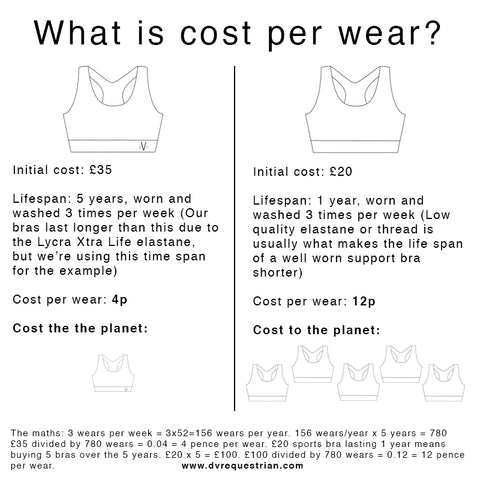What does cost per wear mean and why is it important?
What is cost per wear?
Cost per wear is a concept used to determine the value of an item of clothing by dividing the purchase price by the number of times it is worn. It's a way of calculating the real cost of an item over time, rather than just looking at the purchase price.
In the example below, when we look a bit closer at cost per wear, we can see that a £20 bra is actually 3 x the cost of the £35 bra over it's lifespan.

For example, if you buy a sports bra from us that costs £35 and wear it 35 times, (That's less than once per week which is very likely considering they'll be your go-to any time you're riding for their amazing support and comfort.) then the cost per wear is £1. Let's say you wore it 3 times a week, that's 156 wears that year, that's 22 pence per wear. Now let's say that went on for 5 years (Our sports bras will last way longer, i've had mine for over 5 years and it still looks almost new, but just for this exercise we'll say 5), that then becomes 4 pence per wear...
Let's now take a cheaper sports bra that costs £20, and let's say this one only lasted 1 year when being worn and washed 3 times per week. (Very likely when elastic isn't good enough quality etc). This means the cost per wear has been 12p, and you're now having to buy a new one costing you another £20, and then another the year after. So all together over that 5 years you're actually spent £100 instead of £35. Which one is better value for money?
The lower the cost per wear, the better value the item is considered to be. This can be helpful when deciding whether to purchase an item, especially if it is expensive.
It is also important to remember that cost per wear only takes into account the monetary cost and doesn't consider the sentimental value or the environmental impact of buying new clothes. It is way better for the planet as well as your pocket to buy clothes that last longer and that you are going to treasure and feel proud to own. It's also great if you can purchase products that can be washed at lower temperatures and air dry quickly so you're using less energy.
Can more expensive products be better value?
More expensive products can sometimes be better value, but it depends on the specific product and how it is being used.
Quality
More expensive products are often made with higher quality materials and better craftmanship, which can make them last longer and perform better than cheaper items.
Durability
More expensive products are usually made to last longer. They might be more resistant to wear and tear, and require less frequent replacement, which can make them better value in the long run.
Brand reputation
More expensive products often come from well-known and reputable brands, which can add to their value, as consumers trust these brands to delivery high-quality products.
Features
More expensive products often come with additional features and functions, which can make them more versatile and useful, and therefore a better value.
Cost per wear
As explained earlier, if an expensive product is worn frequently, the cost per wear will be lower than a cheaper product worn the same amount of times.
However, it is important to note that more expensive products aren't always better value. Sometimes, cheaper products are just as good or even better than expensive ones. However, is this the case for the planet? What are they made from? It's important to do your research and consider the sentimental value and environmental impact of buying new clothes.
Are more expensive products better for the environment?
Expensive products are not necessarily better for the environment. The environmental impact of a product depends on various factors such as the materials used, how it is produced, and how it is disposed of.
Materials
More expensive products may be made with higher-quality and more sustainable materials, such as organic cotton or recycled fabrics. But this is not always the case, some expensive products may use fabrics that are not good for the environment so check the labels.
Production
More expensive products may be made in facilities that have higher environmental standards, such as using renewable energy or recycling water. However, this is not always the case. Brands that care about the environment will usually share more of this type of information on the brand areas of their websites.
Disposal
More expensive products may be more durable and have a longer lifespan, which can decrease the amount of waste generated and decrease the need for new products to be produced, reducing the environmental impact. However, some expensive products may be made with materials that are not recyclable or biodegradable, which can have a negative impact on the environment.
It is important to consider the environmental impact when making a purchase, but the price is not a reliable indicator of a product's environmental impact. It's important to research the materials, production, and disposal of a product before making a purchase, to make an informed decision.











Leave a comment